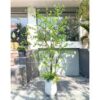The Impact of Blue Willow China on Minimalist Lifestyle: Timeless Elegance and Functional Simplicity

In the world of interior design and lifestyle trends, the minimalist movement has gained significant momentum over the past few decades. It emphasizes simplicity, functionality, and the removal of excess, allowing individuals to focus on what truly matters in their living spaces. Minimalism is not just about reducing clutter; it is about creating a peaceful environment that promotes balance, clarity, and intentional living.
At the same time, Blue Willow China, a traditional blue-and-white porcelain pattern with roots dating back to the 18th century, has become a beloved symbol of refined elegance and timeless beauty. Known for its intricate design featuring pagodas, willow trees, birds, and flowing rivers, Blue Willow China has long been cherished as a representation of grace and serenity.
In this article, we explore how Blue Willow China fits within the minimalist lifestyle and how it can influence and enhance minimalist living. By examining its aesthetic appeal, cultural significance, and potential role in a minimalist home, we will uncover how this iconic pattern embodies the principles of minimalism while adding sophistication and timeless charm to modern living spaces.
1. The Essence of Minimalism: A Focus on Simplicity and Functionality
Minimalism, as a lifestyle and design philosophy, is built upon the idea that less is more. The goal is to simplify your surroundings by eliminating unnecessary items, leaving only what is essential or meaningful. The minimalist movement extends beyond physical spaces and influences various aspects of daily life, including relationships, personal habits, and material possessions.
In home design, minimalism encourages a focus on clean lines, neutral colors, open spaces, and functional furniture. The aim is to create an environment that fosters calmness and clarity, providing a sanctuary from the chaos and distractions of modern life. Every item in a minimalist home should serve a purpose, whether it is functional, aesthetic, or both.
Blue Willow China, with its balance of simplicity and intricate design, fits perfectly within this philosophy. While it boasts a detailed, historical pattern, its muted blue-and-white color palette allows it to blend seamlessly with minimalist aesthetics. In this way, Blue Willow China can be integrated into minimalist living spaces without overwhelming the environment, offering a touch of elegance without sacrificing simplicity.
2. The Timeless Appeal of Blue Willow China: A Classic Design for Modern Times
One of the defining characteristics of Blue Willow China is its enduring popularity and timeless charm. The pattern, created in the 18th century, has remained an iconic symbol of refined taste and traditional craftsmanship. Despite its long history, the design continues to appeal to contemporary sensibilities due to its classic aesthetic and cultural significance.
The motif, which typically features a landscape with pagodas, willow trees, flying birds, and a romantic love story, evokes a sense of serenity, nature, and harmony. The soft blue and white color combination is understated yet elegant, making it adaptable to various interior design styles, including minimalism.
Minimalist design is about creating spaces that feel serene and uncluttered, yet still reflect personal style and taste. Blue Willow China offers a unique opportunity to add visual interest and sophistication to a minimalist home without disrupting the tranquil atmosphere. The pattern’s serene imagery can bring a sense of calm to any space, enhancing the minimalist philosophy of simplicity while celebrating beauty in its purest form.
3. Blue Willow China and the Principle of Less Is More
At first glance, the intricate design of Blue Willow China may seem at odds with the minimalist principle of simplicity. However, the pattern’s impact on minimalist living lies in how it strikes a balance between intricacy and restraint. The key to incorporating Blue Willow China into a minimalist lifestyle is understanding its ability to add visual interest and texture while maintaining a sense of balance and calm.
In a minimalist home, the inclusion of a few carefully chosen Blue Willow China pieces can serve as focal points, offering subtle elegance without overwhelming the space. For instance, a single Blue Willow China vase on a clean, white shelf or a set of Blue Willow dinnerware arranged on a dining table can serve as a beautiful yet functional accent that draws attention without detracting from the minimalist design.
The beauty of Blue Willow China lies in its ability to contribute to a minimalist aesthetic through the principle of “less is more.” Its simple color palette and serene motifs allow it to complement minimalist furniture and décor, while its history and craftsmanship add depth and meaning to an otherwise sparse environment. The key is to use it sparingly, allowing each piece to stand out and be appreciated for its own inherent beauty.
4. Blue Willow China in Minimalist Dining Spaces
In minimalist dining spaces, where clean lines, simplicity, and functionality are paramount, Blue Willow China can make a significant impact. The pattern’s timeless appeal, coupled with its practical use as dinnerware, makes it an ideal addition to a minimalist dining area.
A minimalist dining table often features simple, unembellished surfaces with few items, but a well-placed set of Blue Willow China can elevate the space without overwhelming it. Whether it’s a dinner plate, bowl, or teapot, the intricate design and calming colors of Blue Willow China bring an element of sophistication to the table while maintaining the minimalist aesthetic of the room.
Blue Willow China can also be incorporated into a minimalist kitchen. A few carefully placed pieces, such as a Blue Willow serving platter or tea set, can bring style to an otherwise utilitarian space. By incorporating these items sparingly and intentionally, you can create a sense of refined elegance without cluttering the room.
The beauty of using Blue Willow China in minimalist dining areas lies in its ability to serve both functional and aesthetic purposes. The pieces are not only beautiful but also practical for everyday use. By selecting a few pieces of Blue Willow China that align with your personal style and needs, you can create a dining space that is both simple and elegant, emphasizing the minimalist principle of “useful beauty.”
5. Blue Willow China as a Statement Piece in Minimalist Interiors
Minimalism is about creating spaces that are thoughtfully curated and visually harmonious, where each item is chosen with care. In minimalist interiors, every piece of furniture, décor, or accessory serves a purpose, whether it’s functional or decorative. Blue Willow China can play a role as a statement piece, adding character and refinement to a minimalist space without overpowering it.
For example, a Blue Willow China teapot or platter can be displayed as a decorative accent on a mantelpiece, console table, or open shelving. These pieces not only serve as functional items but also become works of art, offering texture and pattern in an otherwise simple room. The subtle elegance of Blue Willow China helps create a visually interesting focal point while maintaining a sense of simplicity and balance.
In a minimalist bedroom or living room, Blue Willow China can be used sparingly as an accent piece, perhaps as a vase holding a single flower or as a decorative plate displayed on the wall. Its delicate design and soft color palette make it the perfect addition to a minimalist space that values beauty without excess.
6. Blue Willow China and Mindful Consumption
Minimalism is not just about reducing the number of possessions you own; it is also about being intentional with your choices and practicing mindful consumption. In the context of Blue Willow China, this means selecting pieces that hold personal significance, are made with quality craftsmanship, and will stand the test of time.
Instead of collecting numerous decorative items, the minimalist approach encourages curating a small selection of high-quality pieces that are both functional and meaningful. Blue Willow China fits perfectly within this philosophy. Its timeless design ensures that each piece remains relevant and beautiful for generations to come. Additionally, the durability and practicality of Blue Willow China make it a sustainable choice, as it can be passed down and enjoyed for years.
By choosing Blue Willow China as part of a minimalist lifestyle, individuals embrace the principle of quality over quantity. Each piece is thoughtfully chosen to enhance the space, and the pattern’s enduring appeal ensures that it remains a cherished possession rather than a passing trend.
7. Conclusion: Blue Willow China as a Bridge Between Tradition and Minimalism
In the modern world of minimalist design, Blue Willow China serves as a bridge between tradition and contemporary living. Its elegant design, rich cultural history, and versatile aesthetic make it a perfect addition to minimalist homes that value simplicity, functionality, and beauty.
Whether used as a statement piece in a minimalist living room, as functional dinnerware in a dining area, or as a decorative accent in various spaces, Blue Willow China brings a sense of timeless elegance and sophistication to minimalist interiors. It adds depth and meaning to the minimalist philosophy, celebrating beauty in simplicity while honoring craftsmanship and tradition.
Incorporating Blue Willow China into a minimalist lifestyle allows individuals to embrace the principles of less is more without sacrificing style, culture, or elegance. By thoughtfully integrating these beautiful, functional pieces into your home, you can create a space that reflects both the serenity of minimalism and the richness of tradition.

